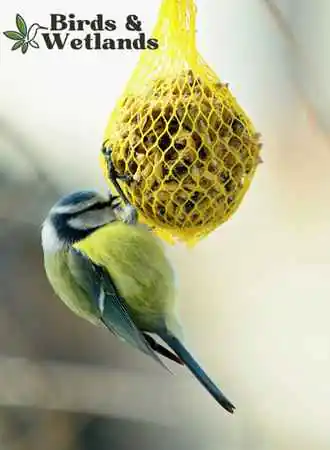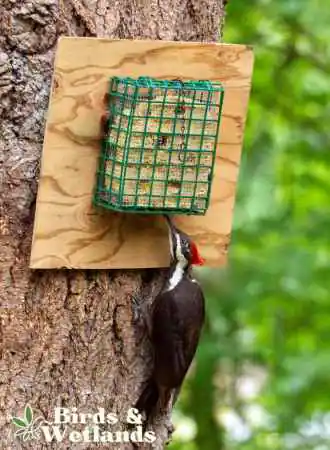Suet, a high-fat food made from hard fat and other ingredients, is a superfood for birds that provides essential nutrients and energy.
Several bird species are attracted to suet due to its high fat content, especially in the cold months when they need more energy. Woodpeckers, nuthatches, chickadees, jays, and starlings are known to eat suet. Warblers, wrens, and even the occasional cardinal or hawk may be attracted to suet feeders. Offering suet can attract a variety of interesting species to your backyard.
Key Takeaways On Suet Cakes For Wild Birds
What Birds Eat Suet?
Many types of birds enjoy suet due to its high fat content, making it an excellent source of energy, particularly during the colder months. However, certain species are particularly known to be attracted to suet. Here’s a list of some of these birds:
- Woodpeckers: Downy woodpeckers, hairy woodpeckers, red-bellied woodpeckers, and pileated woodpeckers are all known to love suet.
- Nuthatches: Both white-breasted and red-breasted nuthatches are often seen at suet feeders.
- Chickadees: Both black-capped and Carolina chickadees enjoy suet.
- Titmice: The tufted titmouse is a common visitor to suet feeders.
- Wrens: Carolina wrens and house wrens will eat suet, especially if it’s mixed with some seeds or insects.
- Jays: Both blue jays and stellar’s jays are known to eat suet, although they might cause a bit of a ruckus at the feeder.
- Starlings and Grackles: These birds also enjoy suet, but be aware that they can sometimes monopolize feeders and deter other birds.
- Northern Flickers: These large woodpeckers are also attracted to suet.
- Warblers: Certain types of warblers, such as the yellow-rumped warbler, will eat suet during the winter months.
- Kinglets: Both ruby-crowned and golden-crowned kinglets can be attracted with suet.
Remember that different birds might be attracted to different types of suet, so you might want to experiment with a few different suet recipes. For example, some birds might be attracted to suet mixed with seeds, while others might prefer suet with fruit or insects mixed in. And remember, always use high-quality ingredients to ensure the birds are getting a healthy meal.
What is bird suet?
Suet is a type of fat commonly obtained from beef or mutton which is also called suet, but it can also be derived from other animals, such as pork, venison, or even insects. It is a dense, energy-rich food that provides birds with the necessary nutrients and calories to stay warm and survive cold temperatures.
It is composed of mostly saturated and monounsaturated fats, providing birds with a concentrated energy source. It also contains small amounts of protein, vitamins, and minerals essential for maintaining a healthy immune system and overall well-being. It is easy for birds to digest and is readily metabolized, making it an excellent energy source for birds during winter.
Types of Suet
Several types of suet are available in the market, including plant-based options for those who prefer to avoid animal products. Plant-based suet is typically made from a combination of vegetable oils and other natural ingredients like corn meal, soy flour, and peanut butter. It is an excellent option for vegetarian and vegan bird lovers.
Other ingredients are often mixed with rendered beef suet to create a homemade recipe. Common ingredients for homemade suet include black oil sunflower seeds, cracked corn, peanuts, dried fruit, oatmeal, cornmeal and other bird food. These ingredients not only add flavor and variety to the rendered beef fat but also provide additional nutrients and energy for the birds.
For those who want to experiment with making their own suet mixtures, it is essential to follow some practical tips to ensure that the suet is safe and healthy for birds. It is crucial to avoid using ingredients high in salt or sugar, as they can harm birds. It is also important to ensure that the suet mixture contains no artificial preservatives or additives.
When making suet at home, it is recommended to use high-quality, food-grade suet and to melt it down slowly over low heat to prevent scorching. Once the suet has melted, the additional ingredients can be mixed in and allowed to cool before being shaped into a block or placed in a feeder.

What are the benefits of feeding birds suet?
Suet is a high-energy food source that is rich in fats and proteins, which can help birds maintain their body temperature and provide the energy they need for flight and other activities. Suet is also a good food source for birds during the winter months and cold climates when other food sources may be scarce.
Suets can attract a variety of bird species to your backyard, which can provide opportunities for birdwatching and create a more vibrant ecosystem.
Is suet better than birdseed?
During the colder months, bird suet can be a great alternative to bird seed. Suet is a high-energy food that is especially beneficial for birds during the winter when they need to consume more calories to maintain their body temperature. It is also more efficient for delivering food to birds as it doesn’t require special feeding apparatus like birdseed feeders.
One of the biggest advantages of suet over birdseed is less waste. Unlike birdseed, which can easily be scattered and lost, suet is a solid block that birds can cling onto and peck at, reducing the amount of food that goes uneaten and wasted. Suet is also very easy to store and transport, making it convenient for bird watchers.
However, it’s important to note that suet is not a year-round substitute for other types of bird food. In warm weather, suet can melt and stick to birds’ feathers. It can also spoil quickly, harming birds and their chicks. It’s essential to take down suet feeders during the warmer months and store them in the freezer until the weather cools down again.

When should you put out suet for birds?
Suet can be offered to backyard birds year-round, but it is especially beneficial during the winter months when other food sources may be scarce. In general, it’s best to start offering suet in the fall before the weather gets too cold so that birds have time to become accustomed to the new food source before they really need it.
It’s also important to note that suet can melt in high temperatures, so it should be removed or kept in the shade during the summer months to prevent it from spoiling or becoming rancid. Feeders should be cleaned regularly to prevent the buildup of bacteria and other contaminants that can be harmful to birds.
Wild Bird Copper Suet Feeder
A Must-Have for Bird Lovers
- Triple Capacity: Hold up to 3 cakes or a large brick for continuous bird feeding.
- User-Friendly: The EZ Fill design ensures effortless reloading of bird feed.
- Weather-Proof: Its unique roof design keeps feed dry, ensuring birds can feast in any weather.
- Comfort-First Design: The vinyl coating prevents birds’ feet from freezing in winter or burning in summer.
What are the different ways to offer birds actual suet?
There are several different ways to offer suet to birds. Here are some of the most common methods:
- Suet feeders are specifically designed to hold suet and prevent it from falling out or becoming contaminated. They are available in various styles, including cages, baskets, and logs.
- Suet cages are small wire cages filled with suet and hung from a branch or hook. They are a simple and effective way to feed birds such as downy woodpeckers, hairy woodpecker, red-bellied woodpeckers, black-capped chickadees and other small clinging birds.
- Suet plugs are small cylinders of suet that can be inserted into a specially designed suet plug feeder. They are a convenient and mess-free way to offer suet to birds.
- Suet baskets are small baskets that can be filled with suet and hung from a branch or hook. They are similar to suet cages but may have a more decorative appearance.
- Using materials like pinecones, orange halves, or mesh bags, you can also make your own suet holders. Simply fill the holder with suet and hang it from a branch or hook.
- Serve suet in a platform feeder or smear suet on tree branches.

Regardless of your chosen method, it’s important to offer suet in moderation and in appropriate feeders to prevent overconsumption and potential harm to birds. Suet feeders should be cleaned regularly to prevent the buildup of bacteria and other contaminants that can be harmful to birds.
How often should I replace suet?

The frequency at which you should replace suet depends on several factors, including the temperature and the number of birds visiting your feeder. Generally, you should replace suet every 3 to 5 days in moderate temperatures and every 1 to 2 days in warmer temperatures. Downy woodpecker and other small birds will visit feeders with a variety of suet cakes.
If the suet looks moldy, rancid, or has an unpleasant odor, it should be replaced immediately. Suet should be replaced if it becomes contaminated with droppings, feathers, or other debris.
Regularly cleaning your feeder and keeping it in a shaded area can help extend the life of the suet and prevent it from spoiling too quickly.
Where should you place suet for birds?

When placing suet for birds, it’s important to choose a location that is safe and accessible for birds. Hang suet feeders in a sheltered location, such as under a tree or eave, to protect the suet from the elements. Suet can melt in direct sunlight and spoil quickly in rainy or wet weather.
Birds should be able to easily access the suet feeder without obstruction. Avoid placing suet feeders near dense vegetation or structures that can obstruct the birds’ flight path. Keep suet feeders at a safe height by hanging them at a height that is safe for birds to access but out of reach of pets and other animals.
Suet feeders can attract predators such as cats and raccoons. Hang suet feeders at least 10 feet away from structures and vegetation that can provide cover for predators.
Placing suet feeders near other bird feeders can create a convenient feeding station for birds and attract a diverse range of bird species to your backyard.
Can you feed suet to birds in the summer?
While suet is often associated with winter bird feeding, it is possible to feed suet to birds in the summer as well. However, there are some things to keep in mind when offering suet to birds during the summer months.
One of the main concerns with offering suet during the summer is that it can melt and spoil quickly in high temperatures. To prevent this, it’s important to keep suet feeders in a shaded location or bring them inside during the hottest part of the day. Suet feeders should also be cleaned and refilled regularly to prevent the buildup of bacteria and other contaminants.
Another consideration when offering suet in the summer is that birds may not be as interested in it as they are in other food sources, such as insects or fruit. To make suet more appealing to birds in the summer, you can try offering it in smaller quantities or mixing it with other foods, such as mealworms or dried fruit.
Should you buy suet or make it at home?

Whether to buy commercial suet or make your own suet cakes depends on your personal preference and the availability of resources.
Buying suet cakes can be convenient and save time. You can purchase pre-packaged suet cakes or blocks from pet stores, garden centers, or online retailers. Buying suet ensures that you get a high-quality product specifically formulated for birds.
Making homemade suet cakes can be a fun and rewarding experience. You can customize the ingredients and flavors to suit your local bird species and preferences. Homemade suet is also typically less expensive than store-bought suet.
If you choose to make suet at home, be sure to use high-quality raw suet and other ingredients and follow a trusted recipe. Avoid using ingredients that are harmful to many birds, such as salt, sugar, or chocolate. Be sure to store homemade suet in the refrigerator or freezer to prevent spoilage.
What other animals does suet attract?
Suet is a high-energy food source that is attractive to many animals, not just smaller birds. Some of the other animals that may be attracted to suet include squirrels, raccoons and bears.
Squirrels and raccoons are notorious for raiding bird feeders. They are skilled climbers and can easily access suet feeders not placed in squirrel-proof locations or equipped with squirrel baffles.
In areas where bears are present, suet cakes may pose a risk to both bears and humans. It’s important to avoid feeding bears and to remove feeders during the bear’s active season.



